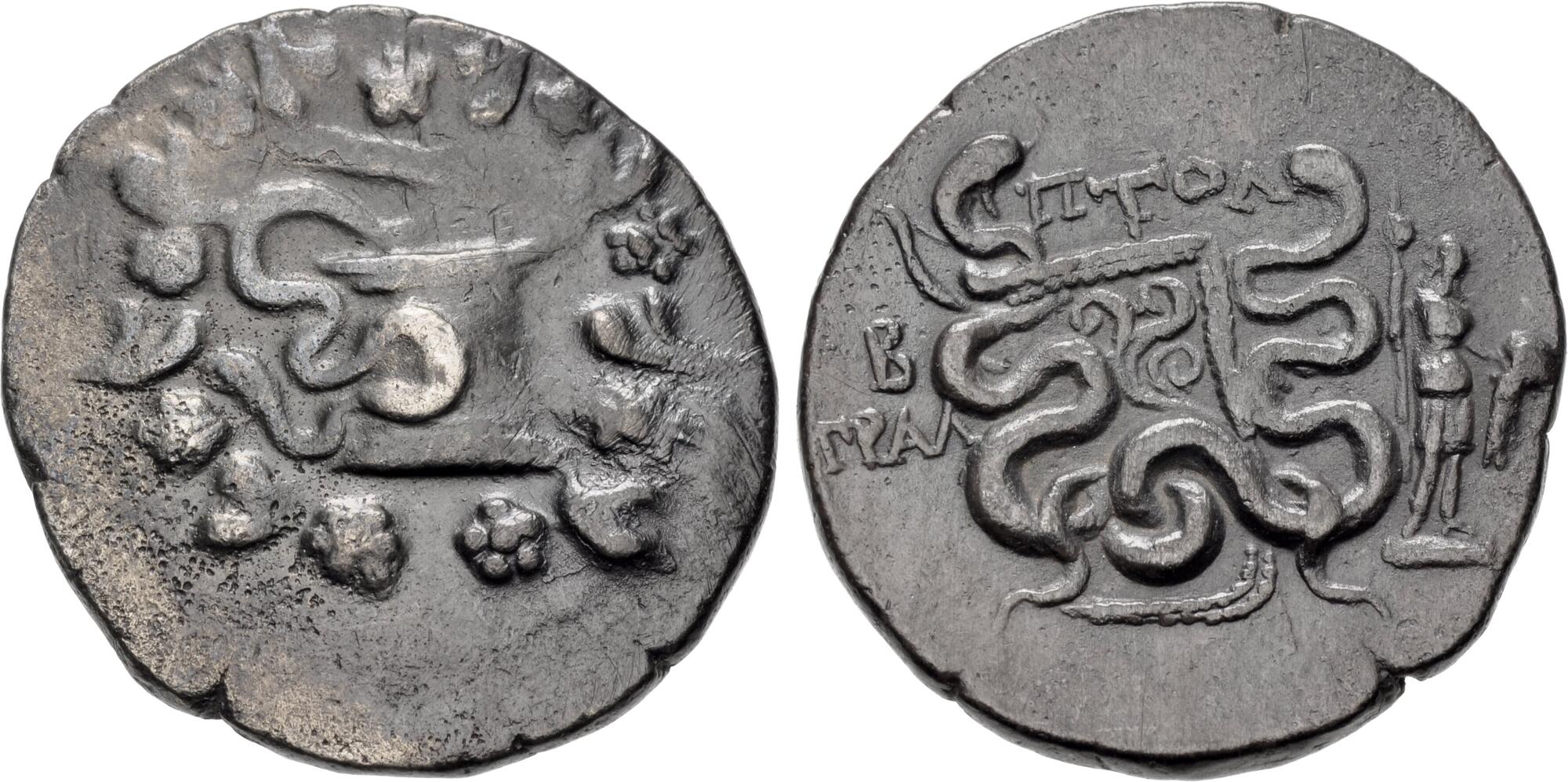Tralles, silver, cistophori (cista/bow case between two snakes) (85-77 BCE)
From SILVER
85 BCE - 77 BCE Silver 11,995 kg
Description
| ObverseInscription or printing placed on the obverse.: | Cista mystica, from which serpent emerges, within ivy wreath |
| ReverseInscription or printing placed on the reverse.: | ΠTOΛ above; to left, date above TPAΛ; to right, (Greek).Two serpents entwined around bow and bowcase |
Mint and issuing power
| MintIdentifies the place of manufacture or issue of a numismatic object.: | Tralles | Ancient regionAncient region.: | Lydia | Modern countryModern country: Turkey | AuthorityIdentifies the issuing power. The authority can be "pretended" when the name or the portrait of X is on the coin but he/she was not the issuing power. It can also be "uncertain" when there is no mention of X on the coin but he/she was the issuing power according to the historical sources: | Roman Republic |
Chronology
| FromIdentifies the initial date in a range assigned in a numismatic context. | 85 BCE | toIdentifies the final date in a range assigned in a numismatic context.. | 77 BCE | PeriodTime period of the numismatic object.: Hellenistic 323-30 BC |
Physical description
| MetalThe physical material (usually metal) from which an object is made.: | Silver |
Median weightMedian of the weights of numismatic objects (in grams). in grams | 12.20 | DenominationTerm indicating the value of a numismatic object. Examples: tetradrachm, chalkous, denarius.: | cistophorus |
StandardStandard.: |
Image

Tralles_cistophori_85_77.jpg [1]
References
| Die study referencePublication of the study: | Carbone 20211Carbone 2021, p. 24 | ||
| Coin series referenceReference to coin series study: | |||
| Coin series web referenceCoin series web references: | |||
Obverse dies distribution
no distribution is available
Reverse dies distribution
no distribution is available
Quantification
| Number of obversesNumber of obverse dies. ᵖ (o) | 38 | Number of singletons (o1)The number of singleton coins. ᵖ | 4 |
| Number of reverse diesNumber of reverse dies. (r) | Number of coinsNumber of coins. (n) | 110 | |
| Coins per obverse dieNumber of coins per obverse die. (n/o) | 2.89 | Coins per reverse dieNumber of coins per reverse die. (n/r) | |
| Reverse per obverse ratioRatio of obverse dies divided by reverse dies. (r/o) | Percentage of singletons (o1)number of coins (n) divided by the number of singletons (o1) ᵖ | 10.53 % | |
| Original number of dies (O) (Carter 1983 formula)The estimation of the number of coins according to Carter 1983 ᵖ | 49.16 | Coins struck if 20,000 as average productivity per dieCoins made if the average productivity for obverses (according to Carter) is 20,000. ᵖ | 983,200 |
| Original number of dies (O) (Esty 2011 formula)The estimation of the number of coins according to the singleton formula in Esty 2011 ᵖ (O) | 58.06 | Survival rate if 20,000 as average productivity per dieSurvival rate if average productivity is 20,000. ᵖ | 0.00011 |
| Coverage (o = % of O) (Esty 1984 formula)Esty 1984 - coverage (% of O) ᵖ (o = % of O) | 96.36% | Die productivity if survival rate 1/2,000Average productivity if survival rate is 1/2,000. ᵖ | 4,475.18 |
| Weight of silver (in kg) if 20,000 coins per die (O = Carter formula)Carter 1983 * Median weight * 20000 (*10 if gold or electrum) ᵖ | 11,995 kg <br /> 11,995 kg | Die productivity if survival rate 1/5,000Average productivity if survival rate is 1/5,000. ᵖ | 11,187.96 |
Remarks
Likely military
References
- ^ Carbone, Lucia (2021), "Roman Taxation and Monetary Production: The Case of the Provincia Asia up to 48 BC," in M. Kelly and P. Pacha (eds.), Capitalism’s Past. An Inquiry into the Possibility of Pre-Modern Capitalism, p. 1-36.